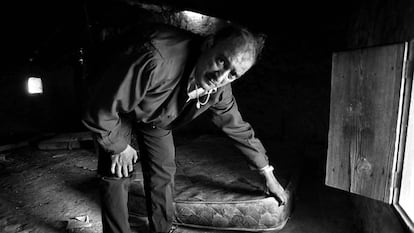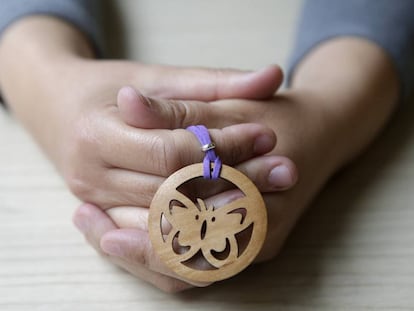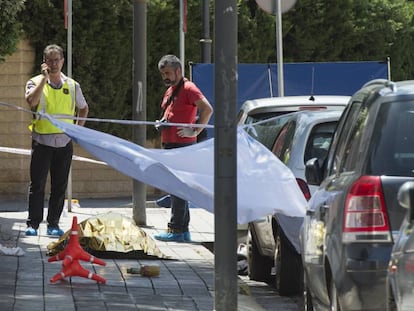Makers of Netflix’s ‘Alcàsser Murders’: “We saw that evil was among us”
The directors behind the new documentary, Ramón Campos and Elías León Siminiani, discuss why they thought it was time to shed new light on one of Spain’s most notorious murder cases
A new documentary released on Friday by streaming platform Netflix explores the excesses committed by the Spanish media in the early 1990s, particularly by emerging private television networks, in connection with a crime that shocked the nation: the Alcàsser case.
The nascent private networks proved how far they were determined to go in the battle for audience ratings
Director Ramón Campos
The film – titled The Alcàsser Murders in English and El Caso Alcàsser in Spanish – is the first original Netflix documentary in Spanish, and sees directors Ramón Campos and Elías León Siminani revisit a triple murder that has been studied in-depth by Spanish criminologists. In November 1992, three teenage girls from the Valencian village of Alcàsser – Miriam García, Toñi Gómez and Desirée Hernández – were abducted, raped, tortured and killed after hitching a ride to a nearby nightclub. Their bodies were found 75 days later and two men were suspected of committing the crimes: Miguel Ricart, who served 21 years in prison, and Antonio Anglés, who became a fugitive from justice and has never been located.
The case was covered extensively on prime-time television, and gruesome details of the crime were discussed at length, leading to a debate over the boundaries between journalism and reality TV.
Campos and Siminari are convinced that it was necessary to reopen this particular Pandora’s Box, all these years later.
Question. What was there left to say about the Alcàsser crime?
Elías León Siminani: Our work chronicles events from the time of the girls’ disappearance, in November 1992, until today. The verdict was handed down in 1997, but its social legacy endures.
Ramón Campos: To shed light on events can heal the wounds, and in this case, the wounds are deep. The media went in there without thinking about what they were doing to that village, and they cut deep. In the Valencia region, music societies are very important institutions, they are the heart of the village. In Alcàsser, the music society is located right next to the council. That fateful program in which [Antena 3 presenter] Nieves Herrero interviewed the families on the same night that the autopsies were being conducted took place in there. For me, it’s a metaphor of how far things went, and how deep the wounds are.
Q. Why are we still attracted by a story that’s been told so many times?
R. C.: It happened in 1992: Spain was on a roll, it hosted the Barcelona Olympics and the World Expo in Seville that year, there was no crisis yet, and the Socialist Party was not in freefall. And then three young girls go missing and the bubble bursts, we get slapped in the face by reality, and suddenly we see that evil is walking among us. It was a triple homicide involving horrible violence, and the nascent private networks proved how far they were determined to go in the battle for audience ratings.
E. L. S.: It is a compendium of things to help us understand the society we live in today.
R. C.: And then there was the fact that the main suspect, Antonio Anglés, got away. If the protagonist is missing from a crime scene, interest in the case grows exponentially.
Q. One of the main plots in the series is the descent into hell of Fernando García, the father of one of the victims, Miriam. He was caught up in a spiral of denial, rejecting the official investigation and returning time and again to prime time to posit increasingly outlandish theories. How did you find him these days?
R. C.: He has rebuilt his life, and now has a daughter who is Miriam’s age. In the first chapter, a psychologist warns: “When you make a victim feel like the center of attention out of the fact of being a victim, you are triggering a dangerous thing. That person is going to want to keep on being a victim.” It’s a downer when the media abandon you, it makes you feel like an orphan.

Q. His descent began when he met the criminologist Juan Ignacio Blanco, a somewhat shady character.
E. L. S.: To me, there are two clear periods in this case. The first one covers the 75 days from November 1992 to January 1993, between the time that the girls went missing and the time the bodies were found. The climax of this period was the special television shows that were aired that night. The second major period was 1997. At that point Spain was already at a different moment in time politically, socially, economically and even in terms of its television industry. Blanco made his appearance during this second act. Fernando García had been collecting signatures across Spain for a popular initiative to change the law and make rapists and killers serve their full sentences. That’s when Blanco offered him a new opportunity to be in the spotlight.
Q. How is Blanco these days?
R. C: Alcàsser has represented a lifelong burden for everyone involved. Blanco was discredited and ostracized by the journalism sector. He paid for what he did.
Q. The program’s great exclusive is the video footage of the trial. Was it hidden away somewhere?
E. L. S.: Jesús Carrascosa, director of what was then [Valencia’s regional public broadcaster] Canal 9, thought that if the O.J. Simpson trial was televised in the US because of great social interest in the case, then Alcàsser – with all its conspiracy theories – should be the first televised trial in Spanish history. He was unsuccessful at getting it aired, but he did manage to have it recorded and stored at Canal 9’s archives, where it was available to students of journalism and law.
R. C: Nobody knew exactly where it was. We were supposed to have turned in the finished documentary last year. Then, after a year’s worth of negotiations, 700 Betacam tapes turned up containing 400 hours of footage.
Q. Your series offers many ideas that later turn out to be conspiracy theories.
A. C.: That is what happened in Spain. The girls went missing, the crime was investigated, the theories were put out there and covered on the [popular late night show] Esta noche cruzamos el Missisissippi.
After a year’s worth of negotiations, 700 Betacam tapes turned up containing 400 hours of footage of the trial
Director Ramón Campos
Q. Would things be any different now?
R. C.: We’ve gained transparency. In the days of Alcàsser, the Civil Guard did not even have a press department, nor did it feel any need to. This fueled the propagation of alternative theories by other means. Compare that with the Diana Quer murder, where Civil Guard officers gave a news conference detailing the case so that nobody would be able to question it.
Q. And what has the media learned since then?
R. C: I’m still seeing images like the ones we saw back then, which turned my stomach.
E. L. S: The demand for content creation, to survive the constant pressure of news immediacy, remains the same.
English version by Susana Urra.
Tu suscripción se está usando en otro dispositivo
¿Quieres añadir otro usuario a tu suscripción?
Si continúas leyendo en este dispositivo, no se podrá leer en el otro.
FlechaTu suscripción se está usando en otro dispositivo y solo puedes acceder a EL PAÍS desde un dispositivo a la vez.
Si quieres compartir tu cuenta, cambia tu suscripción a la modalidad Premium, así podrás añadir otro usuario. Cada uno accederá con su propia cuenta de email, lo que os permitirá personalizar vuestra experiencia en EL PAÍS.
¿Tienes una suscripción de empresa? Accede aquí para contratar más cuentas.
En el caso de no saber quién está usando tu cuenta, te recomendamos cambiar tu contraseña aquí.
Si decides continuar compartiendo tu cuenta, este mensaje se mostrará en tu dispositivo y en el de la otra persona que está usando tu cuenta de forma indefinida, afectando a tu experiencia de lectura. Puedes consultar aquí los términos y condiciones de la suscripción digital.
More information
Últimas noticias
Most viewed
- Sinaloa Cartel war is taking its toll on Los Chapitos
- Oona Chaplin: ‘I told James Cameron that I was living in a treehouse and starting a permaculture project with a friend’
- Reinhard Genzel, Nobel laureate in physics: ‘One-minute videos will never give you the truth’
- Why the price of coffee has skyrocketed: from Brazilian plantations to specialty coffee houses
- Silver prices are going crazy: This is what’s fueling the rally












































